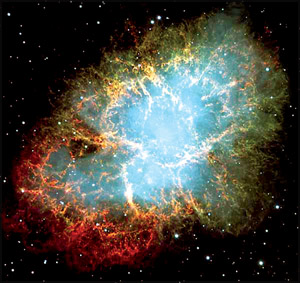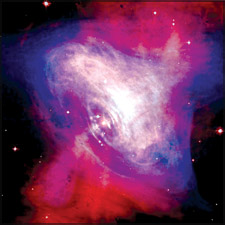 What
is a supernova? What
is a supernova?
Has 'Human Torch' of the
movie 'Fantastic Four' been one of your super heroes? He is really an
interesting character who can create flames beyond the temperatures of
the 'supernova' as mentioned in the movie as well as in the comic book.
Coming back to true science, there really is a phenomenon called
supernova and if you remember, you may have seen the term appearing on a
few of the earlier editions of 'Space Station'. Therefore, let's see
what 'Human Torch' claims to be capable of, in a real world perspective
(mental view).
In short, a supernova is a stellar explosion that creates an
extremely bright object. A supernova results in a burst of radiation
that may outshine its entire host galaxy for a short period, before
fading from view. During this short interval, a supernova can radiate as
much energy as the Sun would emit (give out) over ten billion years.
However, you must know that this short period of time spans over
several weeks or months. On astronomical time scales, this kind of a
duration is considered pretty short.
This explosion emits much or all of a star's material at a speed of
around one tenth of the speed of light. This produces a shock wave which blasts out into the surrounding
space, and it sweeps up an expanding shell of gas and dust which is
called a supernova remnant.
light. This produces a shock wave which blasts out into the surrounding
space, and it sweeps up an expanding shell of gas and dust which is
called a supernova remnant.
Quick facts
* Nova means 'new' in Latin, referring to what appears to be a very
bright new star. The prefix 'super' distinguishes supernovae from
ordinary novae.
An ordinary nova is a situation where a star increases its
brightness. However, brightness in such a scenario is less than a
supernova, and takes place through a different mechanism.
* The earliest recorded supernova, known as SN 185, was viewed by
Chinese astronomers, way back in AD 185.
* On average, a supernova occurs about once every 50 years in a
galaxy of the size of the Milky Way.
* Supernovae play an important role in enriching the interstellar
medium with heavy elements. Furthermore, the shock waves produced by the
supernova explosions can begin the formation of new stars.
* A near-Earth supernova which can happen at a distance less than one
hundred light years can have effects on the biosphere due to the gamma
rays emitted.
Several large stars within the Milky Way have been suggested as
possible supernova within the next few thousand to hundred million
years.
Varieties of supernovae
There are several types of supernovae which generally start due to
two reasons. These processes are extremely complex, but we shall keep
aside those complexities and get the basic idea of what happen in these
phenomena. One of the two reasons which creates the explosion of a
supernova is the turning off of a star.
 This
happens when the star grows older and the energy generation by nuclear
fusion stops. Since the original gravitational pull still exists, all
the material get pulled towards the centre of the star, mostly creating
a black hole. This is known as the core collapse. This
happens when the star grows older and the energy generation by nuclear
fusion stops. Since the original gravitational pull still exists, all
the material get pulled towards the centre of the star, mostly creating
a black hole. This is known as the core collapse.
The potential energy that is released, heats up the outer layers. The
core collapses in on itself with speeds which can reach as much as
70,000 kilometres per second. As a result, the density is increased at a
fast rate, and the temperature too increases rapidly.
The next reason is the opposite of the above, where the explosion can
take place when a star suddenly turns on and produces energy through
nuclear fusion.
The most common way which this can happen is when a white dwarf star
accumulates sufficient material from a stellar companion to raise its
core temperature enough to ignite(kindle or cause) carbon fusion, at
which point it undergoes runaway nuclear fusion, completely disrupting
it.
Space News:
Throwing a boomerang in space
 Playing
with boomerangs might surely have been a thrilling experience for you
and you might have even made your own boomerang at home. However, a
Japanese astronaut has planned to throw a boomerang inside a space
station to test how it can fly in zero gravity which can be quite
different to what happens when we throw one under the effect of gravity. Playing
with boomerangs might surely have been a thrilling experience for you
and you might have even made your own boomerang at home. However, a
Japanese astronaut has planned to throw a boomerang inside a space
station to test how it can fly in zero gravity which can be quite
different to what happens when we throw one under the effect of gravity.
This will be done by Astronaut Takao Doi, who is set to travel on a
US shuttle in March to the International Space Station, where he will be
in charge of construction of a Japanese scientific testing room. It is
believed gravity is needed for a boomerang to fly back to the throwing
spot, but no one has tried in zero gravity.
Doi has decided on boomerang tests after he had received a request
from Yasuhiro Togai, a world boomerang champion from the western
Japanese metropolis of Osaka and he has undergone training from the
world champion on how to throw it.
Aravinda Dassanayake |
